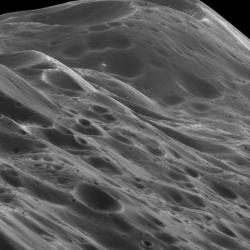We asked, and Cassini delivered; amazing, intriguing images of the surface of Saturn’s moon Iapetus. The spacecraft completed its latest flyby on September 10th, 2007, skimming just 1,640 km above the moon’s surface. Scientists will be digesting the photographs for years.
During this most recently flyby, Cassini passed 100 times closer than its previous Iapetus flyby in 2004. At this distance, the spacecraft was able to reveal the moon’s strange bulging shape, equatorial ridge, and pattern of bright and darkness across its features.
Many of its photographs focus in on the bizarre mountain ridge that circles the moon’s equator, like a seam. The new Cassini images showed that this ridge is mountainous, rising as high as 20 km, and extends across more than half its circumference.

The mystery deepens with the unusual light and dark hemispheres of Iapetus. One side is as white as snow, and the other is as black as tar. With the new Cassini images, you can actually see where the different regions mix. On the dark side, you can see spots where there are patches of white ice on dark mountainsides. And then on the bright side, you can see blobs of dark material. This dark material forms a very thin coating; probably only a few metres deep, since there are regions where impact craters have punched right through it, revealing white material underneath.
What caused this material? That’s a mystery. Maybe some previous Saturnian moon broke up, and spray painted Iapetus. Or maybe the material is volcanic material that welled up from within the moon. And this could somehow be connected with the moon’s equatorial ridge.
The images from Cassini were actually delayed early Tuesday, because a cosmic ray hit the spacecraft, putting it into safe mode. This happened after it had captured all its images from its flyby, and they were safely stored in memory. After a few hours Cassini came out of safe mode and continued sending its data back to Earth.
Original Source: ESA News Release


Why is 2012 so prevalent as a time of change in so many ancient cultures?
As the evidence becomes overwhelming that we are definitely not alone in this amazing universe that we live in due to our expanding technelogical prowess it will also become more and more evident that time is also a tool that is almost within our grasp.